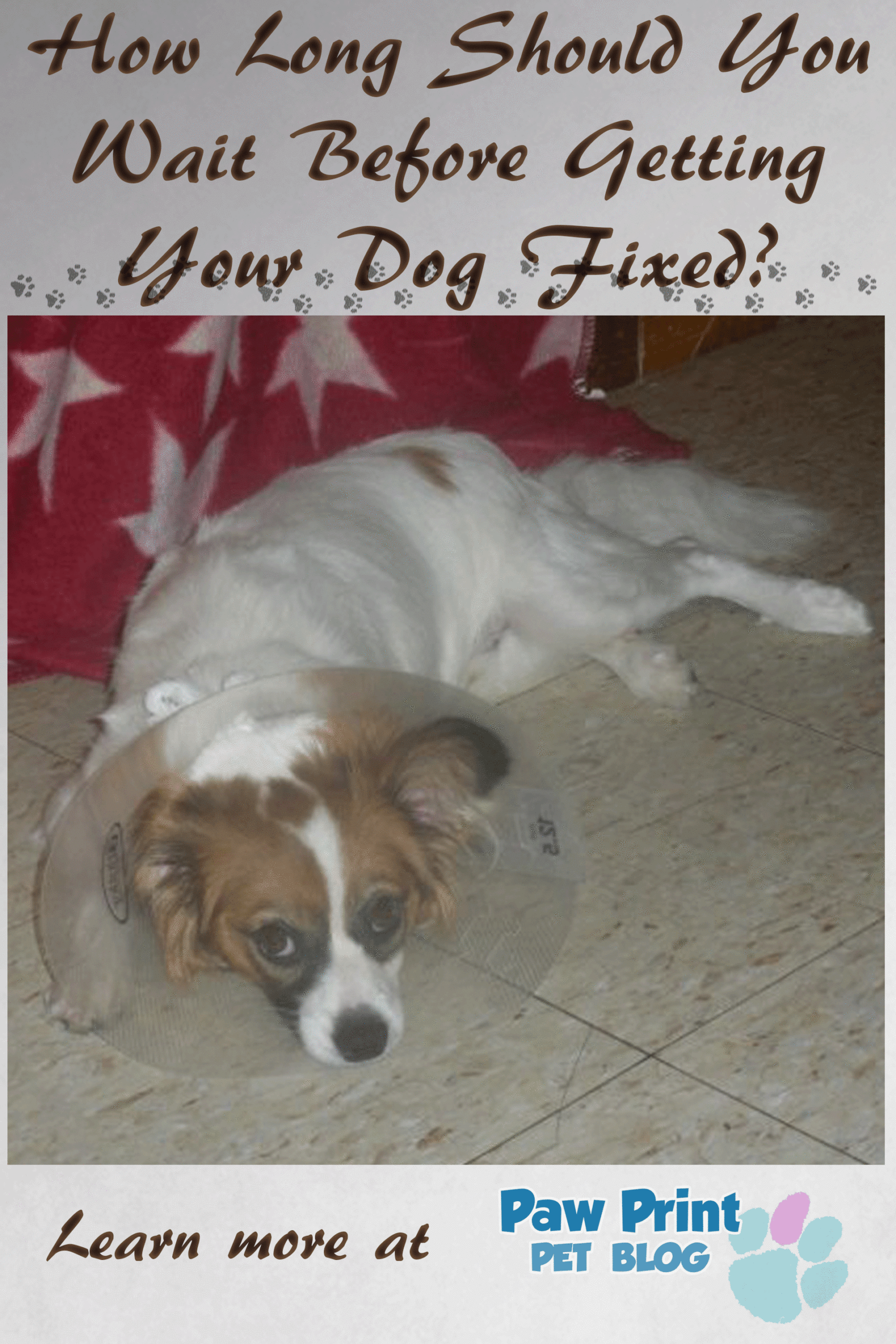For many pet owners, getting their dogs spayed or neutered is a nerve-wracking experience. It can be expensive, especially if you factor in things like presurgical bloodwork and pain medication. For many people, getting their puppy fixed will be their first time experiencing putting their furry family member through surgery. My “puppies”, Kitsune and Fenrir, are 14 and 7 years old now. But I can still remember how worried I was dropping them off for their neuter surgeries. There are a lot of factors you’ll probably consider before deciding on getting your dog altered. Not the least of which is figuring out the right time to get the surgery done. Is there an ideal age when you should get your dog fixed?
Post Contents:
I Wish I Hadn’t Gotten My First Dog Fixed Early
 Kitsune is the first dog that my fiancé and I raised on our own. I adore the dog he has grown to be. But if I had the chance to go back in time there are things I would do differently. I wish I had waited longer to get him neutered. We had him fixed when he was 7 months old, before he was completely finished growing. I didn’t know about the benefits of allowing dogs to finish growing before they are neutered. The vet we went to when Kit was a puppy recommended getting dogs neutered at 6 months old. So that’s what I did.
Kitsune is the first dog that my fiancé and I raised on our own. I adore the dog he has grown to be. But if I had the chance to go back in time there are things I would do differently. I wish I had waited longer to get him neutered. We had him fixed when he was 7 months old, before he was completely finished growing. I didn’t know about the benefits of allowing dogs to finish growing before they are neutered. The vet we went to when Kit was a puppy recommended getting dogs neutered at 6 months old. So that’s what I did.
Those of you who know anything about Kit, probably know that he is an oversized Papillon. Papillons typically weigh 10 lbs or under. Because Kit ended up growing to be taller than normal for his breed, a healthy weight for him throughout his life has been between 18 and 20 lbs. There’s no way I can say for sure that his unusual growth was caused by us getting him neutered young. But I’m sure it didn’t help things any. Sex hormones in dogs, as in people, play a big role in growth and development. Dogs fixed early often times grow taller than their intact counterparts because they lack the normal flow of hormones to signal the timely closure of bone growth plates.
Kit’s size, which has put excess strain on his body throughout his life, may have contributed to him developing health issues, such as IVDD. Again, there’s no way for me to know for sure whether neutering him early strongly contributed to health issues later in life. But I can’t say for sure that it didn’t contribute either.
Doing Things Differently with My Second Dog
I learned a lot in between getting Kitsune and getting my second dog, Fenrir. I decided to wait a bit longer before having Fen neutered. This was complicated a bit by the fact that Fen had cryptorchidism, or an undescended testicle. Undescended testicles are at a higher risk of developing cancer, so it was important to have Fenrir neutered. However, I decided not to rush things and ended up having Fenrir fixed a bit after his first birthday. I had his vet take X-rays first, so that we could be sure that his growth plates had enough time to close normally before his surgery.

Mixed Feedback
I got a lot of mixed feedback when people found out I waited so long to get Fenrir neutered. Many vets still recommend getting pets fixed when they are around 6 months old. Some people in the rescue community recommend having it done even younger. Research I’ve done, on top of personal experience, has convinced me to wait longer before having my personal dogs fixed.
To be clear, I’m not against getting pets fixed. In an ideal world every owner would prevent accidental litters, so fixing pets as a form of population control would not be necessary. We don’t live in an ideal world, and the pet overpopulation problem is heartbreaking. Fixing pets can also provide some benefits, such as eliminating certain types of cancers, reducing or eliminating your pet’s desire to roam (to find a mate), and it can help improve some behavioral problems such marking.
But it’s important to note that, as with most things, there are also cons to fixing animals. While fixing prevents some types of cancers, it can increase the risk of other types – notable of osteosarcoma (bone cancer), and cardiac hemangiosarcoma (tumors in the heart). Fixing dogs has been shown to triple the risk of hypothyroidism. In male dogs it increases the risk of prostate and urinary cancers. In female dogs spaying can cause an increase in urinary tract problems including infections, and spay incontinence. Spayed and neutered dogs have an increased risk of developing orthopedic disorders. They are more prone to displaying adverse reactions to vaccines.
Take Your Individual Situation into Account
So when should you get your pet spayed or neutered? That can vary depending on your individual pet/situation. Small dogs generally reach maturity before larger ones. If you want to be sure your dog is done growing before you spay/neuter, you can ask your vet to use an Xray to look at his/her bone growth plates. A dog who is not yet done growing will still have open growth plates.
Some vets may offer alternatives to traditional spays/neuters. These include things like ovary sparing spays for females, and vasectomies for males. At the end of the day, each owner will have to do their own research and, with the help of their vet, decide what is best for their particular dog. Early spaying/neutering might be the right choice for an owner who doesn’t feel they’ll be able to successfully prevent unwanted pregnancies.
I will say that keeping Fenrir intact for as long as I did ended up being a lot easier than I originally thought it would be. I don’t let my dogs spend time outside unsupervised, so making sure Fen kept away from any interested ladies was easy for us. It will, most likely, be quite some time before I’ll have to deal with this issue again myself. But I know that I don’t ever want to fix another one of my dogs before they are finished growing.
Start Your Research
If you’re reading this because you’re still in the research phase of trying to figure out when you want to get your own dog fixed, I can start you off with links to some studies that I found useful/interesting.
- Long-Term Health Risks and Benefits Associated with Spay / Neuter in Dogs By: Laura J. Sanborn, M.S. May 14, 2007
- Behavioral and Physical Effects of Spaying and Neutering Domestic Dogs (Canis familiaris) Summary of findings detailed in a Masters thesis submitted to and accepted by Hunter College By Parvene Farhoody in May, 2010
- Endogenous Gonadal Hormone Exposure and Bone Sarcoma Risk By Dawn M. Cooley et al. November 1, 2022
- Neutering Dogs: Effects on Joint Disorders and Cancers in Golden Retrievers. By de la Riva, G. T., Hart, B. L., Farver, T. B., Oberbauer, A. M., Messam, L. M., Willits, N., & Hart, L. A.(2013)
- Effects of ovariohysterectomy on reactivity in German shepherd dogs. By Hyeon H. Kim el al. 2006
- Evaluation of the risk and age of onset of cancer and behavioral disorders in gonadectomized Vizslas By M Christine Zink et al.
- Effect of gonadectomy on subsequent development of age-related cognitive impairment in dogs By B.L. Hart
Comment Below!
If you have fixed pets currently, at what age did you have them spayed or neutered? What factors did you take into account before deciding when you wanted to get your dog fixed? If you know of any related studies that I didn’t like to above, let me know and I can add them to the list!

We’ve, unfortunately, been dealing with content scrapers stealing our articles lately. You shouldn’t be seeing this article on any site other than pawprintpetblog.com! If you’re reading this article on any other site, we’d love for you to take the time to contact us and let us know and, if you have the time, stop by and visit us on our official site! Thanks you.





No Comments